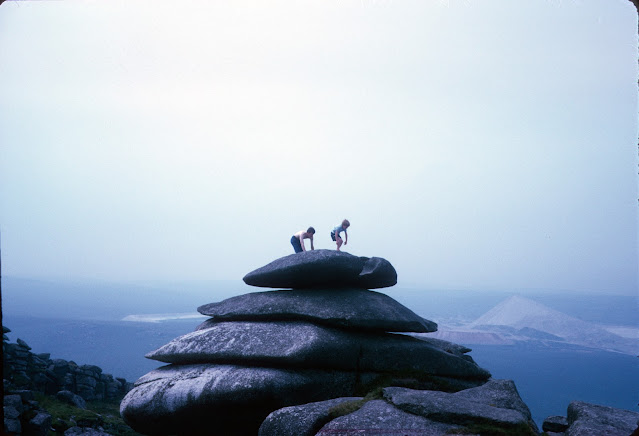Play wild, live well: The value of managing risk from an early age
 |
| Rock climbing fun for my brother (right) on a childhood holiday in Cornwall: no guard rails here! |
When we lived in England in the early 1970s, I loved visiting my aunt Vivian, as she lived in a large house and kept horses. Kitty was the gentle one, so I was eager to test out my (very) rudimentary horse handling skills one day by bringing her over from the stables to the house on my own. What I knew about horses came mostly from reading my favourite Jilll-and-her-ponies books, rounded out with instructions and role modelling from Vivian who loved her animals and was fearless around them. At age 13 or so, I wanted to be the same.
Which is what led me to believe I could ride Kitty over from the stables with only a halter as tack — no saddle or bridle. I don’t remember how I got on her, but I surely remember falling off her. She was a clever horse, so when she detoured to the enormous tree just beyond the stable yard she must have known what she was doing with the rank amateur “riding” her. I, on the other hand, had no idea. Which is how I found myself on the ground, having been knocked off Kitty’s bare back by the branches she walked under.
I was essentially unhurt (scraped knees and elbows) but thoroughly shaken and walked Kitty the rest of the way. I sheepishly confessed to Vivian what I had done. She called me foolish and I learned that pride does, indeed, come before a fall.
I’m pretty sure that this experience is what the experts are saying children need more of these days. New research is suggesting that “risky play can enhance children’s health and wellbeing” and that children should be kept “as safe as necessary during play, not as safe as possible.” Give the kids room to take risks as a way of learning limits and, I would argue, the satisfaction of finding those limits themselves rather than having them imposed by well meaning adults. I’m confident that Vivian would not have let me ride Kitty bareback on my own without her leading the horse (around that big tree, for example!), but I was keen to prove myself and so I put myself into the risky riding situation I ended up in. It could have ended disastrously, to be sure, but it didn’t. So, all’s well that ends well so far as this example goes.
And I learned an important life lesson: I would need a lot more learning and practice before I could call myself a horsewoman the equal of my book’s heroine Jill! And that’s a lesson I remember to this day, which is transferable to many areas of my life. By all means, climb onto the bare back of a horse, Amanda, but know just how little control you will have over her. Book learning is valuable and effective, but it goes only so far. Hands-on learning and focused training teaches us skills best.
I no longer have any urge to get on a horse’s back, but I retain a love and, importantly, a deep respect for those giant animals. That, too, I learned from my experience with Kitty. For me, the risk I didn’t even realize I was taking was well worth it for all I got out of it.
..............................................................................................................
To receive my weekly blogpost in your inbox, use the SUBSCRIBE feature (above, in the left-hand column), or email fiveyearsawriter at gmail dot com. Put SUBSCRIBE in the subject line.
Land acknowledgement: I respectfully recognize that I live on the original lands of Anishinaabe, Cree, Oji-Cree, Dakota and Dene peoples, and on the homeland of the Métis Nation.



Love this reminder of, oh so many, near misses!
ReplyDeleteAh, the daring life of youth. I recall so much from your story.
ReplyDelete